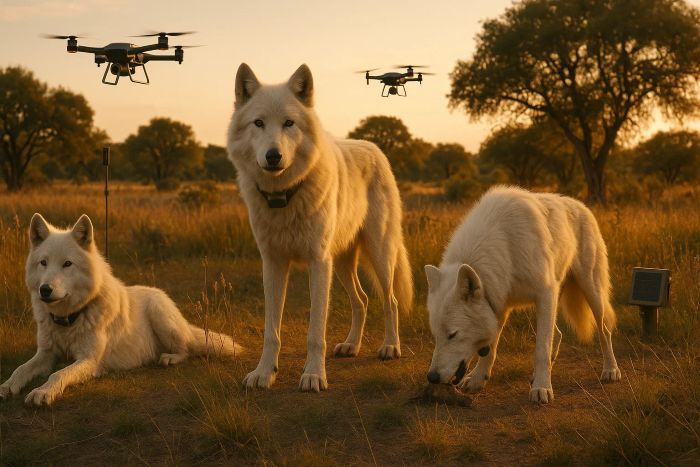Romulus, Remus, and Khaleesi – the world’s first de-extinct dire wolves – are providing unprecedented opportunities to study behaviors that haven’t been observed for over 12,500 years. Born through Colossal Biosciences’ groundbreaking genetic engineering, these animals were named after mythological and pop culture references: the male twins after Rome’s legendary founders and the female after a Game of Thrones character.
The wolves reside on a secure 2,000-acre preserve at an undisclosed location, where they are closely monitored by Colossal’s scientific team. According to Matt James, Colossal’s chief animal officer, the wolves are “habituated to people” but not domesticated. The two older males are “exploring more and more of their habitat every day” while maintaining regular returns to their base for twice-daily feeding.
In terms of behavioral differences from modern wolves, Colossal CEO Ben Lamm observed that initially the dire wolves were “more playful and kind of more puppy-like” than their contemporary relatives, though these traits have evolved as the animals matured.
At just six months old, the male dire wolves already weigh approximately 80 pounds and display distinctive physical and behavioral traits. To observers, they appear as “very big wild dogs with slightly larger skulls and an elongated muzzle,” but their behaviors reveal their unique evolutionary adaptations.
Scientists are particularly interested in studying the dire wolves’ characteristic vocalizations, especially their howling and whining patterns, which differ from modern wolves. These vocalizations, along with their hunting, social, and territorial behaviors, provide invaluable insights into canid evolution and ecology.
The secure facility where the wolves live is equipped with extensive monitoring systems including security personnel, drones, and live camera feeds, allowing researchers to observe and document the animals’ behaviors while ensuring both their safety and containment.
Revelations in Dire Wolf Behavior
The behavioral monitoring program implemented at the wolf preserve represents one of the most comprehensive animal observation studies ever conducted. Using a combination of non-invasive technologies including high-definition cameras, drones with thermal imaging capabilities, and embedded environmental sensors, researchers can track the wolves’ movements and interactions 24 hours a day without disrupting their natural behaviors.
This continuous monitoring has revealed several fascinating behavioral patterns unique to dire wolves. Unlike modern gray wolves, which typically establish and defend rigid territorial boundaries, the dire wolves appear to utilize a more fluid territorial system. They frequently rotate between different core areas within their habitat, suggesting an adaptation that may have allowed prehistoric dire wolves to follow migrating prey herds more efficiently.
The social dynamics between Romulus, Remus, and the younger Khaleesi have provided particularly valuable insights. Despite being born months apart and to different surrogate mothers, the three wolves have established a cohesive social unit with clear but flexible leadership roles. The brothers initially maintained co-dominant status, but as they mature, subtle hierarchical shifts are becoming apparent through body language and vocalization patterns.
Their hunting behaviors are still developing, but already show distinctive characteristics. While modern wolves typically rely on endurance and pack coordination to exhaust prey over long distances, the dire wolves display more ambush-oriented behaviors, utilizing their greater strength and jaw power. This aligns with paleontological theories that dire wolves evolved to take down larger Pleistocene megafauna with powerful, decisive attacks rather than prolonged chases.
Perhaps most intriguing are their vocalizations, which researchers have been methodically recording and analyzing. The dire wolves produce lower-frequency howls with distinctive harmonic patterns not observed in other canids. These vocalizations carry further over open terrain and may have evolved to allow prehistoric packs to coordinate over the vast territories they likely patrolled.
As the wolves continue to mature, researchers expect to document increasingly complex behaviors, particularly as Khaleesi reaches reproductive age. While there are currently no plans for breeding, the wolves’ developing reproductive behaviors will provide additional insights into the social structure and family dynamics of this once-extinct species.




